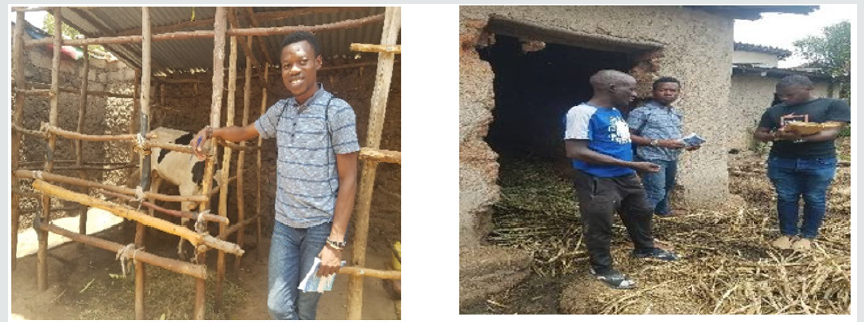
Lupine Publishers Group
Lupine Publishers
Menu
ISSN: 2637-4749
Mini Review(ISSN: 2637-4749) 
Climate Change Adaptation, Health and Shelter Management Practices for Dairy Animals by Smallholder Farmers in Nyanza District in the Southern Province of Rwanda Volume 3 - Issue 3
Gboluwaga J Olaomo and Olawale E Olayide*
- Centre for Sustainable Development, University of Ibadan, Ibadan, Nigeria
Received: January 27, 2020; Published: February 05, 2020
Corresponding author: Olawale E Olayide, Centre for Sustainable Development, University of Ibadan, Ibadan, Nigeria
DOI: 10.32474/CDVS.2020.03.000164
Introduction
Just like every other agricultural sub-sector, the dairy industry is prone to the impacts of climate change. Climate change forces water and land to become more limited for fodder production and causes temperatures rises, requiring changes to forage feeding systems. Also, increase in temperatures requires changes to forage feeding systems. Climate change is having substantial effects on the environment and other natural resources upon which the livestock sub-sector depends [1]. There is direct impact and indirect effects of climate change to dairy production brought about by change in feed and fodder supply which affects livestock production system [2]. Changes in mean temperatures and rainfall patterns leading to extreme weather variability have been experienced in recent years. These impacts have also affected water availability, heightened frequency and amount of drought incidences, floods, sea level rises pest and disease outbreak among other detrimental impacts [3,4]. However, an extensive array of possible practices have been recognised as sustainable means for smallholder dairy farmers to cope with the challenges of a changing climate is known as Climate change adaptation practice adaptation is the first priority; this may involve the use of improved breed of dairy animals which have the ability to cope up with high temperatures, and drier conditions.
Materials and Methods
The study was conducted in Nyanza district in the Southern Province of Rwanda. Its capital is Nyanza town, which is also the Southern provincial capital. This location was selected due to its peculiarity to climate change especially drought events. Nyanza district has population of more than 320, 000 people (according to 2012 national census). Nyanza is predominantly rural with 7.9% urban and 92.1% rural. The study area has a total population of 2,500 dairy farmers. Proportional sampling was used to get the sample size of 243 respondents using sample size estimator. The data collection methods used included structured questionnaire, key informant interviews, and focus group discussions.
Results and Discussion
Health Management Adaptation Practices
Table 1 shows the health management adaptation practices of dairy farmers. About 39% of dairy farmers engaged in ethno-veterinary practices, 27% engaged in preventive measure like vaccination, 24% give regular health check-up for their cattle, while only 10% had not engaged in any health management practice.
Shelter Management Practices
Most of the dairy farmers (83%) of the farmers agreed to have modification in the shelter (housing unit) management during changing climatic conditions. The use of proper ventilation was the commonest practice adopted to cope with extreme weather (high temperature) condition (49%), other practices adopted include the use of bedding materials in winter (18%), tying of animals under shady trees during summer/hot times, use of sprinklers or mist in summer, and coverage of windows in winter (7%) (Table 2).
Conclusion
Climate change impacts on dairy animals make water and land to become more limited for fodder production; and causes temperatures rise, requiring changes to forage feeding systems and these situations could affect the health and shelter management of dairy farming. Therefore, farmers have to be adopted suitable adaptation practices on health and shelter management.
Recommendations
a. Dairy farmers should be empowered by government
and other relevant institutions (health and veterinary) to
encouraged to scale up climate change adaptation practices in
order to mitigate against the effects of drought, pest infestation,
disease outbreak, emergence of new vectors and livestock
diseases occasioned by extreme weather variability and other
occurrences occasioned by extreme weather variability.
b. As a response to the effects of climate change, dairy
farmers should invest in low-cost fodder development,
conservation and conducive housing units (shelter) in order to
sustain their dairy herd productivity (Figure 1).
References

Top Editors
-

Mark E Smith
Bio chemistry
University of Texas Medical Branch, USA -

Lawrence A Presley
Department of Criminal Justice
Liberty University, USA -

Thomas W Miller
Department of Psychiatry
University of Kentucky, USA -

Gjumrakch Aliev
Department of Medicine
Gally International Biomedical Research & Consulting LLC, USA -

Christopher Bryant
Department of Urbanisation and Agricultural
Montreal university, USA -

Robert William Frare
Oral & Maxillofacial Pathology
New York University, USA -

Rudolph Modesto Navari
Gastroenterology and Hepatology
University of Alabama, UK -

Andrew Hague
Department of Medicine
Universities of Bradford, UK -

George Gregory Buttigieg
Maltese College of Obstetrics and Gynaecology, Europe -

Chen-Hsiung Yeh
Oncology
Circulogene Theranostics, England -
.png)
Emilio Bucio-Carrillo
Radiation Chemistry
National University of Mexico, USA -
.jpg)
Casey J Grenier
Analytical Chemistry
Wentworth Institute of Technology, USA -
Hany Atalah
Minimally Invasive Surgery
Mercer University school of Medicine, USA -

Abu-Hussein Muhamad
Pediatric Dentistry
University of Athens , Greece

The annual scholar awards from Lupine Publishers honor a selected number Read More...







